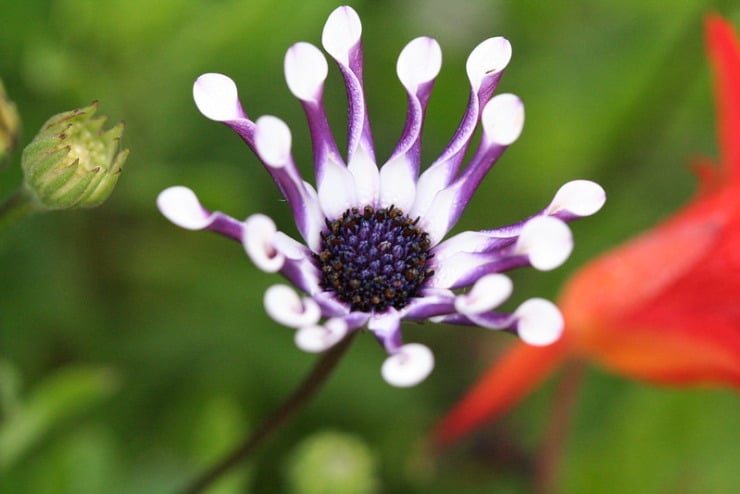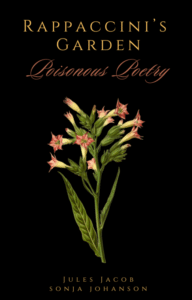
In 1844, Nathaniel Hawthorne published a short story entitled “Rappaccini’s Daughter.” It’s a gothic/horror story about a scientist in Padua who grows poisonous plants in his garden. He has trained his beautiful daughter to tend the garden, and while she has become immune to the poisons, she herself has become poisonous. But her beauty attracts suitors, including the narrator, a young man visiting the city and staying in a room overlooking the garden.
The story is more than a gothic or “garden of evil” tale. It also questions the scientist who believes anything (and anyone) is fair game in the pursuit of knowledge. Hawthorne rolled romantic infatuation, scientific infatuation, and evil into one disturbing story. What he doesn’t get specific about, except for describing a flower or two, is what kinds of plants were actually in the garden.

Jules Jacob
Poets Jules Jacob and Sonja Jackson have an answer: Rappaccini’s Garden: Poisonous Poetry.
At first glance, you might think the collection is a book about plants. Each of the 26 poems occupies a page with a botanical drawing of the plant being described. Rosary pea. White Snakeroot. Mountain Laurel. Lily of the Valley. Ohio Buckeye. Tobacco. White Oak. Opium Poppy. Poison Ivy. Mistletoe. The poems’ titles also include the official scientific name.
But the text of the poems goes beyond, well beyond, the illustrations. Some describe what happens when a plant is eaten. Others describe the plant’s beauty. Some, in non-toxic quantities, can be helpful and healing. But keep in mind that these are plants envisioned for Rappaccini’s garden, and neither they nor the gardener care about ill effects. The focus is the thirst for scientific knowledge.
Deadly Nightshade: Atropa belladonna

paints you miniature
physicians warn, physicians
prescribe objections
sway in dead-up night
in sun-skittering shade.
Belladonna,
quiet our racing hearts
and trembling limbs,
cool angry nerves
snip thread-lives close
our eyes with pupils
still dilated.
It’s an unusual poetry collection, eschewing the usual subjects and themes. Instead, it becomes an overall illustration for the Hawthorne short story, presented as dispassionately as the scientist and his beautiful daughter behave.

Sonja Johanson
Jacob is the author of two previous poetry collections, The Glass Sponge and Kingdom of Glass & Seed. Her poems and writing have been published in numerous journals, including Plume, Tupelo Quarterly, Rust + Moth, Glass, The Fourth River, and others. She’s also a recipient of a fellowship from the Virginia Center for the Creative Arts.
Johanson previously published The Burgeoning World: Poems. Her work has appeared in such journals as Cincinnati Review, American Life in Poetry, Plume, Rhino, and others. She received an M.F.A. in poetry from the Warren Wilson Program for Writers. She works as a horticulturalist in western Maine.
Rappaccini’s Garden: Poisonous Poetry is beautifully precise and descriptive. The juxtaposition of the botanical drawings with the texts of the poems can be mesmerizing. And like the story that inspired it, the collection is also unsettling, raising questions about knowledge and its pursuit.
Photo by Ruth and Dave, Creative Commons, via Flickr. Post by Glynn Young.
How to Read a Poem uses images like the mouse, the hive, the switch (from the Billy Collins poem)—to guide readers into new ways of understanding poems. Anthology included.
“I require all our incoming poetry students—in the MFA I direct—to buy and read this book.”
—Jeanetta Calhoun Mish
- Poets and Poems: Sandra Marchetti and “Diorama” - April 24, 2025
- Poets and Poems: Christina Cook and “Roaming the Labyrinth” - April 22, 2025
- Longfellow’s “Paul Revere’s Ride”: Creating a National Legend - April 17, 2025

L.L. Barkat says
Glynn, what a great intro to their collection! 🙂
That sounds like a very fascinating short story from Hawthorne. A story I had never heard of until now. You always help me learn something new!
Also, it was great to see you last night at the party. Happy. 🙂
Glynn says
I hadn’t read or heard of it either, so I found it online. A strange, rather creepy story, but it fits the author of The House of Seven Gables. And I enjoyed the party ( I need to write a post about my own milkwood experience.)
L.L. Barkat says
Oh, yes, let’s hear about your milkweed experience! (Hope it involves butterflies 😉 )
I shared the story with Sara. Sounds like it could be right up her alley!
Bethany R. says
Glynn thank you for this post. I was trying to figure out why the name Rappaccini rang a bell for me, and you helped me out by pinpointing the Hawthorne story. I read it with my 19th Century American Lit class. So interesting how this collection juxtaposes the botanical drawings with the poetry, as you mentioned.
At the poetry reading, the ending of Jules Jacob’s “Tabacco” poem was so touching. I’m trying to recall her exact wording but I think it was after her daughter is trying to get her to dance and she writes, “Momentarily safe.” Such a beautiful moment she shares with us.
I so enjoyed seeing you and the others at the reading! 🙂 Would love to hear your milkweed story.
Glynn says
“Commands: Look at me, Mama.
Dance like a jellyfish, Mama–
like me. Momentarily safe,
temporarily free.”
During the garden party, I followed the readings by Jacobs and Johanson with my copy. It was fascinating experience to hear the voice as I read the words.
Bethany' says
Thank you for finding that beautiful passage.
Reading while listening is such a rich experience. I think that is my favorite way to take in poems. Like with Laurie Klein’s audio pieces, I read along on the screen as I listen (usually a couple of times).